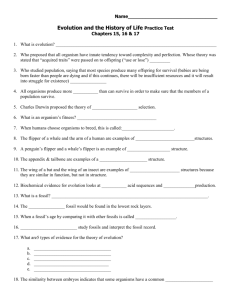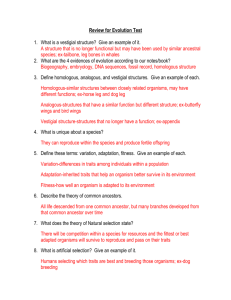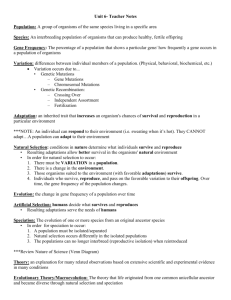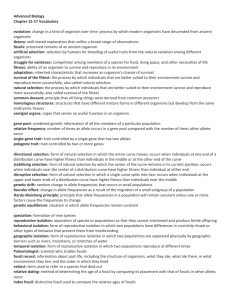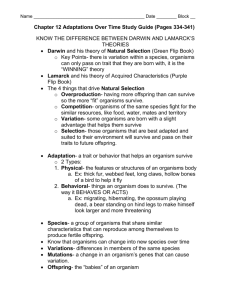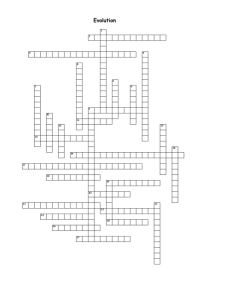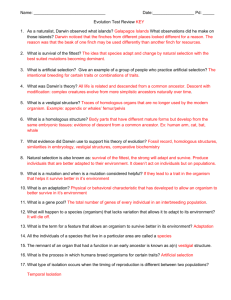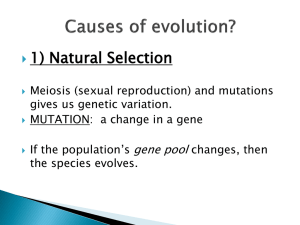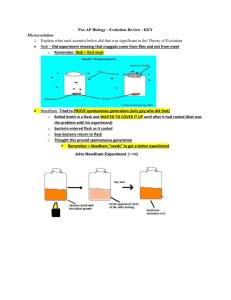Unit Evolution Chapters 15, 16 & 17
advertisement
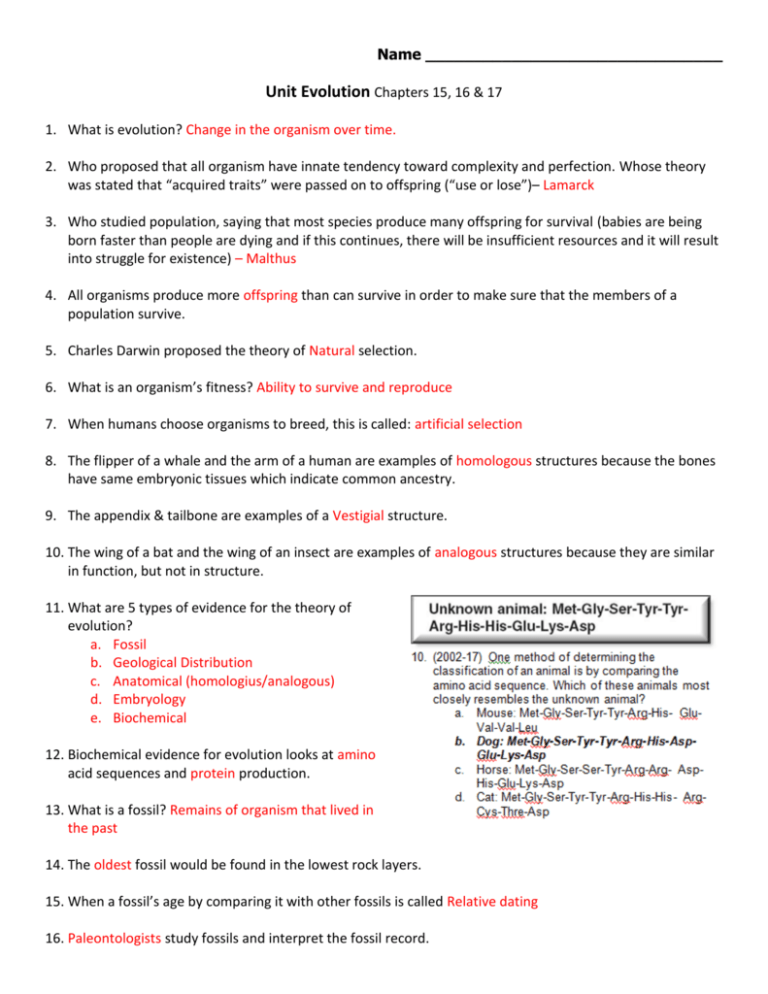
Name _______________________________ Unit Evolution Chapters 15, 16 & 17 1. What is evolution? Change in the organism over time. 2. Who proposed that all organism have innate tendency toward complexity and perfection. Whose theory was stated that “acquired traits” were passed on to offspring (“use or lose”)– Lamarck 3. Who studied population, saying that most species produce many offspring for survival (babies are being born faster than people are dying and if this continues, there will be insufficient resources and it will result into struggle for existence) – Malthus 4. All organisms produce more offspring than can survive in order to make sure that the members of a population survive. 5. Charles Darwin proposed the theory of Natural selection. 6. What is an organism’s fitness? Ability to survive and reproduce 7. When humans choose organisms to breed, this is called: artificial selection 8. The flipper of a whale and the arm of a human are examples of homologous structures because the bones have same embryonic tissues which indicate common ancestry. 9. The appendix & tailbone are examples of a Vestigial structure. 10. The wing of a bat and the wing of an insect are examples of analogous structures because they are similar in function, but not in structure. 11. What are 5 types of evidence for the theory of evolution? a. Fossil b. Geological Distribution c. Anatomical (homologius/analogous) d. Embryology e. Biochemical 12. Biochemical evidence for evolution looks at amino acid sequences and protein production. 13. What is a fossil? Remains of organism that lived in the past 14. The oldest fossil would be found in the lowest rock layers. 15. When a fossil’s age by comparing it with other fossils is called Relative dating 16. Paleontologists study fossils and interpret the fossil record. 17. The similarity between embryos indicates that some organisms have a common ancestor. 18. A study of the kinds and number of genes in a population is population genetics 19. What is a gene pool? All alleles of all gene in a population 20. What is microevolution? Small gene pool changes 21. Members of the same species that live in the same area are population 22. Natural Selection allows fit individuals to survive and reproduce. This causes change in population, as organisms with trait favorable to the environment survive, reproduce and pass on their favorable traits to their next generation. 23. The population of peppered moths turned from light to dark in order to suit their environment. This was caused by natural selection. This phenomenon is called Industrial melanism 24. The Hardy-Weinberg principle states that allele frequencies in a population will remain constant unless one or more factors cause those frequencies to change. That means species stay the same unless environment changes. The equation shows how often alleles occur in a population. 25. When genetic equilibrium is reached, the allele frequencies remain constant 26. What conditions are required to maintain genetic equilibrium? 1. There must be random mating 2. The population must be very large 3. There can be no movement into or out of the population 4. No mutations No natural selection 27. In order for evolution to occur there must be a change in allele frequency (genetic equilibrium will be disrupted) 28. What is genetic drift? random change in allele frequency 29. Earth’s first atmosphere contained little or no O2 The photosynthetic bacteria became common in the shallow seas. These organisms produced oxygen, as an end product of photosynthesis. 30. In order for evolution to occur there must be natural variation. 31. The two main sources of genetic variation are mutation & gene shuffling 32. A mutation can change a gene 33. When two species begin to look alike because they occupy the same environment, this is convergent evolution. 34. Darwin’s finches were an example of a adaptive radiation which is when many species evolve from a common ancestor. 35. Geographic isolation is when populations are separated from each other by a mountain range, new river, etc. 36. Define half-life of an element. The time it takes ½ of it to decay 37. If I have 60 grams of an element, how much will I have after 3 half-lives? 7.5 grams. 38. In certain population the frequency of allele (p) in homozygous dominant individual is 0.8, and frequency of allele (q) in homozygous recessive individual is 0.2 What is the predicted frequency of heterozygous offspring if population is in Hardy Weinberg equilibrium? 2pq = ____________ 39. divergent evolution- 2 organism from one common ancestor 40. convergent evolution - 2 organisms from 2 different ancestor evolve to look similar because of the environment 41. adaptive radiation - one trait is improved in an organism 42. directional selection - one extreme is best & selected for 43. stabilizing selection - average is best & selected for 44. disruptive selection - both extremes are best & selected for 45. Reproductive isolation is necessary for formation of new species. 46. behavioral isolation - different rituals 47. geographic isolation - Separated by a large barrier like an ocean 48. temporal isolation - mating at 2 different seasons. 49. According to Darwin, biological change that is slow and steady, is known as Gradualism. 50. Two species evolve in response to changes in each other over time, it is called Coevolution. Organisms that are closely connected to one another by ecological interactions evolve together. Ex flowering plants can reproduce only if the shape, color, and odor of their flowers attract a specific type of pollinator. 51. The evolutionary model that is characterized by long periods of no change with sudden, abrupt changes occurring is called as punctuated equilibrium. *Read over all notes & Chap 15, 16, 17 from the textbook, handouts, labs, worksheets. *Be able to calculate half-life and Hardy Weinberg’s problem

